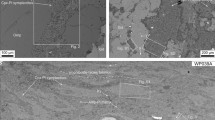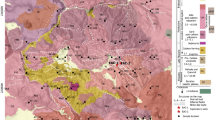Abstract
Volcanic gaseous mixtures emitted from active volcanoes frequently show variable amounts of saturated (alkanes), unsaturated (alkenes) and aromatic volatile hydrocarbons. Three major patterns of distributions can be recognized, apparently related to the chemical-physical environment of formation of the gas exhalations: alkane-rich, low-temperature gas emissions from recently active volcanic areas; aromatic-rich hydrothermal manifestations; and alkene-rich, ‘magmatic’ fumaroles on active volcanoes. Thermodynamic data, together with theoretical and practical findings from the petroleum industry, point to two main types of reactions occurring in these volcanic environments: cracking and reforming. Cracking processes, mainly caused by thermal effects, occur when hydrocarbon-bearing hydrothermal fluids enter and mix with a hot and dry, rapidly rising magmatic gas phase. The most probable products are light alkenes with carbon numbers decreasing with increasing reaction temperatures. The presence of aromatic species in hydrothermal fluids can be linked to reforming processes, catalysed by several possible agents, such as smectites and zeolites, generally present in the hydrothermally altered volcanic terranes, and facilitated by long residence times in a hydrothermal envelope.
Similar content being viewed by others
References
Capaccioni B, Coniglio S, Fratini F (1991) Clay minerals on recent products of hydromagmatic activity: considerations on their genesis. Acta Vulcanol 1:69–77
Capaccioni B, Martini M, Mangani F, Giannini L, Nappi G, Prati F (1993) Light hydrocarbons in gas emissions from volcanic areas and geothermal fields. Geochem J 27:7–17
Carapezza M, Nuccio M, Valenza M (1981) Genesis and evolution of the fumaroles of Vulcano (Aeolian island, Italy): a geochemical model. Bull Volcanol 44:548–563
Cioni R, D'Amore F (1984) A genetic model for the crater fumaroles of Vulcano island (Sicily, Italy). Geothermics 2:154–173
Cioni R, Corazza E, Magro G, Guidi M, Marini L (1988) Reactive and inert gases in low temperature fumaroles (Acolian Islands, Italy). SIMP 43:1003–1011
Giggenbach WF (1975) A simple method for the collection and analysis of volcanic gas samples. Bull Volcanol 39:132–145
Giggenbach WF (1980) Geothermal gas equilibria. Geochim Cosmochim Acta 37:1255–1275
Giggenbach WF (1987) Redox processes governing the chemistry of fumarolic gas discharges from White Island, New Zealand. Appl Geochem 2:143–161
Giggenbach WF, Martini M, Corazza E (1986) The effects of hydrothermal processes on the chemistry of some recent volcanic gas discharges. Per Mineral 55:15–28
Girelli A (1969) Petrolio e Petrolchimica. In: Zanichelli N (ed) Trattato di Chimica Industriale ed Applicata. Bologna 2: 929–1126
Mangani F, Cappiello A, Capaccioni B, Martini M (1991) Sampling and analysis of light hydrocarbons in volcanic gases. Chromatographia 32:441–444
Martini M (1989) The forecasting significance of chemical indicators in areas of quiescent volcanism: examples from Vulcano and Phlegrean Fields. In: Latter JH (ed) Volcanic Hazards. Springer-Verlag, Berlin, pp 372–383
Martini M, Piccardi G, Cellini Legitimo P (1980) Geochemical surveillance of active volcanoes: data on the fumaroles of Vulcano (Aeolian island, Italy). Bull Volcanol 43:255–263
Martini M, Cellini Legittimo P, Piccardi G, Giannini L (1986) The fumaroles of Vulcano (Italy): differences in chemical compositions produced by the surface environment. Geothermics 15:205–209
Martini M, Giannini L, Buccianti A, Prati F, Cellini Legittimo P, Iozzelli P, Capaccioni B (1991) 1980–1990: ten years of geochemical investigation at Phlegrean Fields (Italy). J Volcanol Geotherm Res 48:161–171
Matsuo S (1961) On the chemical nature of fumarolic gases of Vulcano Showashinzan, Hokkaido, Japan. J Earth Sci Nagoya Univ 8:80–100
Matsuo S (1988) Activity report of Japanese Group for the chemical prediction of volcanic eruptions. Per Mineral 55:39–53
Stocchi E (1991) Chimica Industriale: Organica. EDISCO, Torino, 378 pp
Sarkisyan SG (1972) Origin of authigenic clay minerals and their significance in petroleum geology. Sedim Geol 7:1–22
Truesdell AH, White DE (1973) Production of superheated steam from vapor-dominated geothermal reservoirs. Geothermics 2:154–173
Zimmerle W (1985) New aspects on the formation of hydrocarbon source rocks. Geol Rundsch 74:385–416
Author information
Authors and Affiliations
Rights and permissions
About this article
Cite this article
Capaccioni, B., Martini, M. & Mangani, F. Light hydrocarbons in hydrothermal and magmatic fumaroles: hints of catalytic and thermal reactions. Bull Volcanol 56, 593–600 (1995). https://doi.org/10.1007/BF00301464
Received:
Accepted:
Issue Date:
DOI: https://doi.org/10.1007/BF00301464




